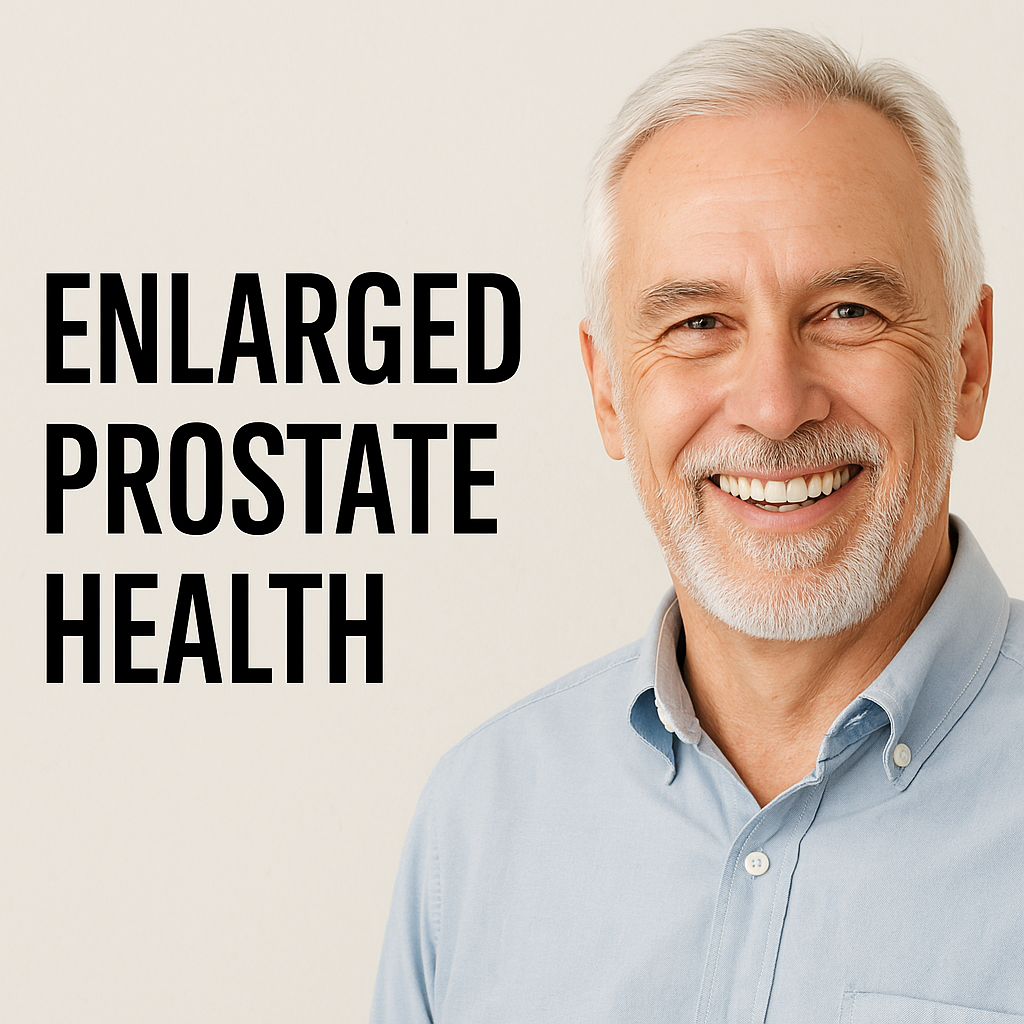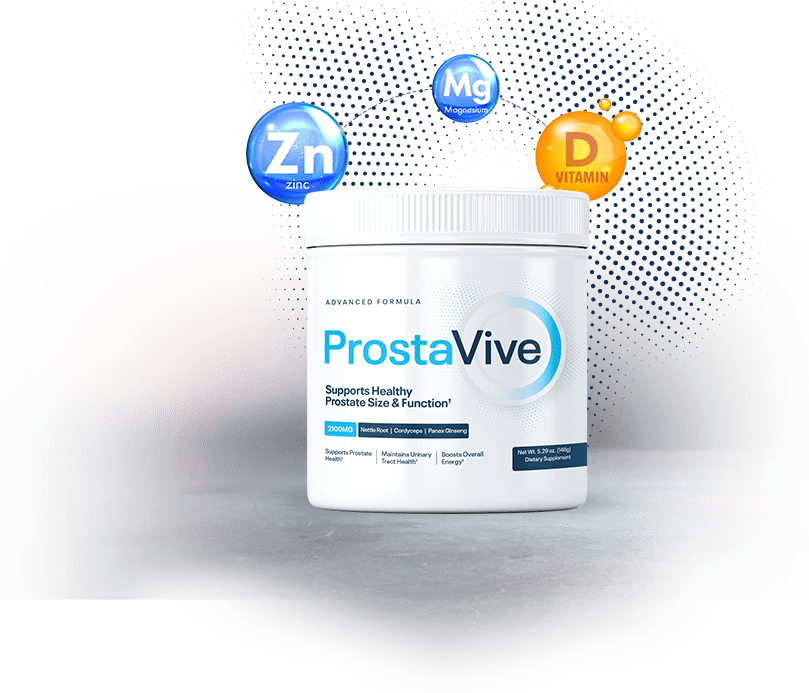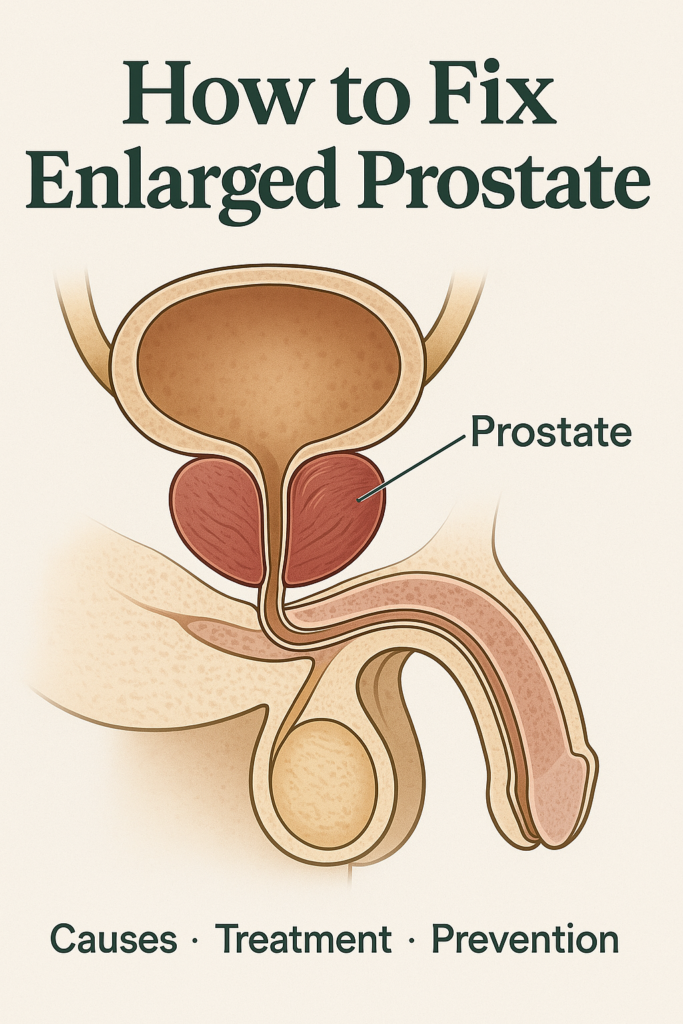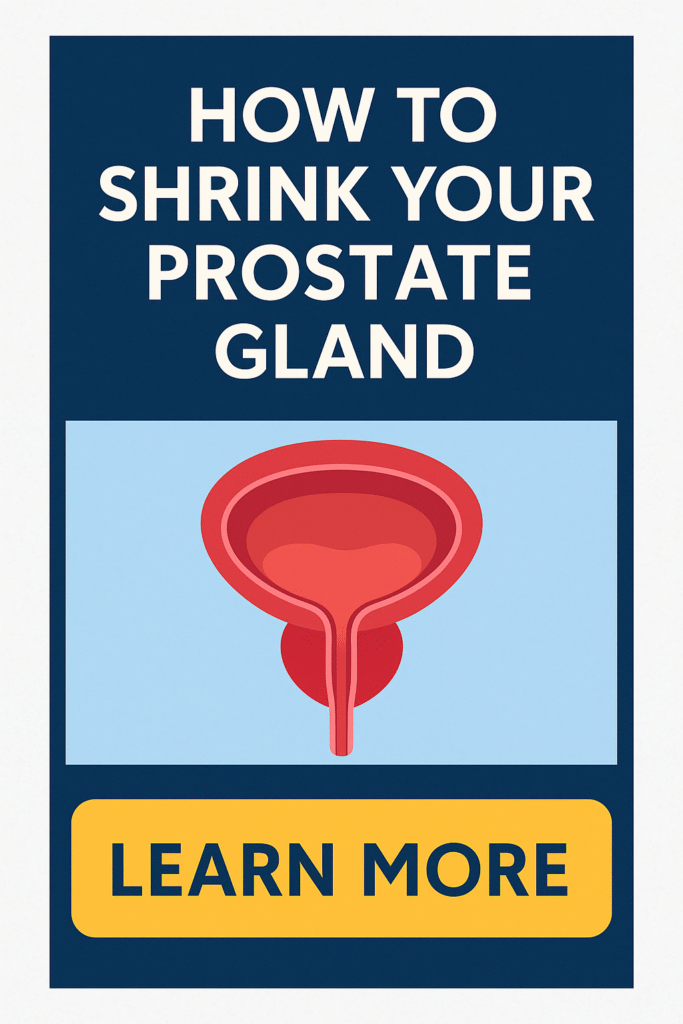Exercises To Shrink Prostate

Exercises To Shrink Prostate: Imagine regaining control over your prostate health with simple yet effective exercises. For many men grappling with the discomforts of prostate enlargement, also known as Benign Prostatic Hyperplasia (BPH), the quest for relief can seem daunting. While medications and invasive procedures are options, there’s a more natural path to explore. This guide is dedicated to unveiling exercise routines that can reduce those burdensome prostate symptoms. But exercise alone may not fully harness your potential for improvement. Pairing physical activity with a natural supplement like ProstaVive could offer significant enhancements to your results. Dive into this article to discover how you can reclaim comfort and health through strategic exercise and supportive supplements.
Understanding Prostate Health
Exercises To Shrink Prostate: Navigating the complexities of prostate health is vital for men seeking to maintain a high quality of life as they age. The prostate gland, a walnut-sized organ located below the bladder, plays a crucial role in male reproductive health, producing seminal fluid that nourishes and transports sperm. However, as men age, they are prone to experiencing issues related to prostate health, notably benign prostatic hyperplasia (BPH), commonly known as prostate enlargement. This guide aims to provide a comprehensive understanding of prostate health, focusing on BPH and other common prostate issues. By shedding light on these conditions and offering insight into exercise routines and natural supplements like ProstaVive, we hope to empower men with the knowledge to manage their prostate health effectively and naturally.
Overview of Benign Prostatic Hyperplasia (BPH)
Benign Prostatic Hyperplasia, or BPH, is a condition characterized by the noncancerous enlargement of the prostate gland. This gland, positioned just below the bladder, can grow as men age, often leading to urinary symptoms that impact daily life. BPH occurs when there is an increase in the number of cells, causing the prostate to press against the urethra and obstruct the flow of urine, leading to symptoms such as frequent urination, a weak urine stream, or difficulty starting urination. The exact cause of BPH remains unclear, but hormonal changes as men age are considered a significant factor, with the condition being exceedingly common in men over 50. Understanding BPH is essential, as it helps men identify symptoms early and seek appropriate management strategies to maintain a good quality of life.
Common Prostate Issues and Their Impact
Prostate issues, while common, can significantly disrupt a man’s quality of life. Symptoms such as frequent urination, nocturia (waking at night to urinate), and a weak urine stream can be bothersome and impact daily activities. These symptoms arise due to the prostate gland’s location around the urethra, where any enlargement can interfere with normal urine flow. Furthermore, these symptoms can affect bladder control and lead to urinary incontinence, dampening confidence and comfort in everyday situations. Beyond urinary symptoms, prostate enlargements can also contribute to sexual dysfunction, adding another layer of concern for affected individuals.
Fortunately, adopting lifestyle changes can mitigate these effects. Regular exercise, particularly Kegel and aerobic exercises, strengthens the pelvic floor muscles and improves blood flow, alleviating some urinary symptoms. Coupled with natural supplements like ProstaVive, which supports prostate health and maintains hormonal balance, these changes offer a comprehensive approach to managing prostate issues naturally and effectively. Striving for a healthy prostate encourages a proactive approach to overall wellness, empowering men to lead active, balanced lives.
Take Control Early
Understanding your prostate health is the first step. Pair your knowledge with natural support like ProstaVive for lasting results.
The Role of Exercise in Prostate Health

Exercises To Shrink Prostate: Prostate enlargement is a common issue faced by men as they age, leading to discomfort and a decline in quality of life. Fortunately, natural approaches, such as specific exercises, offer a promising path to manage these symptoms effectively. This guide is designed to provide valuable insights into various exercises that target prostate health, helping to relieve and potentially reduce the symptoms of an enlarged prostate—a condition medically known as prostatic hyperplasia. By incorporating these exercises into your routine and pairing them with a natural supplement like ProstaVive, you can enhance your overall urinary health and wellbeing. While exercise alone proves beneficial, the combined approach promises a more comprehensive strategy to promote prostate health and reduce related symptoms naturally.
Benefits of Regular Physical Activity
Engaging in regular physical activity is a cornerstone of maintaining a healthy prostate. Exercise not only enhances overall fitness levels but also provides significant physical and hormonal benefits that are crucial for men’s health. By promoting better circulation, regular exercise ensures optimal blood flow to the prostate gland, which is essential for reducing inflammation and supporting overall prostate health. Physical activity also helps in regulating hormones that are linked to prostate growth, potentially minimizing the risks associated with an enlarged prostate. Moreover, incorporating a supplement like ProstaVive can complement these benefits by providing additional nutritional support that targets prostate health specifically, ensuring a holistic approach to combating prostate issues.
While any physical activity can offer some level of support, focusing on tailored exercises that increase blood flow and manage body weight can be particularly effective. This not only helps alleviate urinary symptoms but can also enhance sexual function and general vitality. By maintaining a consistent exercise routine, you can actively contribute to a healthier prostate and an improved lifestyle.
How Exercise Influences Prostate Function
Exercise plays a pivotal role in improving prostate function through enhanced movement and increased blood flow. When you engage in activities, particularly moderate-intensity exercises, your pelvic floor muscles are strengthened, which is crucial for supporting the prostate and bladder control. As a result, regular exercise can alleviate urinary symptoms and improve the flow of urine by reducing pressure on the prostate gland.
Supporting these benefits with targeted supplements like ProstaVive can provide a comprehensive approach to prostate health. This combination works synergistically to enhance blood flow, reduce inflammation, and ensure optimal nutrient delivery to the prostate. Such an approach not only addresses immediate concerns like urinary incontinence and erectile dysfunction but also contributes to long-term prostate health. By making exercise and supplements a part of your daily routine, you empower yourself with a natural, effective strategy to manage prostate health, thus improving both your physical comfort and overall quality of life.
Exercise Smarter
Exercise helps — but combining movement with ProstaVive delivers better, faster outcomes for prostate health.
Essential Exercise Routines for Prostate Health

Exercises To Shrink Prostate: Prostate health is a significant concern for many men, particularly as they age and face challenges such as an enlarged prostate or benign prostatic hyperplasia (BPH). While medication and surgery are traditional treatments, many seek natural methods to support prostate health. This guide introduces essential exercise routines designed to help manage prostate enlargement symptoms. By incorporating a series of targeted exercises like aerobic sessions, interval training, and pelvic floor exercises into your daily routine, you can improve your prostate health and enhance overall well-being. To amplify the benefits of these exercises, incorporating a supplement such as ProstaVive could offer enhanced support, promoting a holistic approach to reducing symptoms and fostering a healthier lifestyle.
Aerobic Exercises
Aerobic exercises offer a straightforward yet effective strategy for enhancing prostate health. Activities such as walking and cycling are accessible options for older men looking to integrate moderate-intensity physical activity into their lives. These exercises help boost cardiovascular health, improve blood flow, and support the prostate gland’s function. Consistency is key; regularly engaging in these activities can aid in managing symptoms associated with an enlarged prostate, such as urinary incontinence and bladder control issues.
For optimal results, consider supplementing your aerobic routine with ProstaVive, a natural product designed to enhance long-term prostate health. This one-two punch of physical activity and dietary supplements effectively maintains prostate wellness, allowing for better management of urinary symptoms and improved quality of life.
Interval Training
Interval training offers an innovative exercise strategy for supporting prostate health, especially beneficial through gentle, controlled movements. By alternating between low and moderate intensity, this approach significantly improves circulation and benefits the prostate gland. Such movement patterns can be seamlessly incorporated into your existing fitness level, accommodating a range of needs from moderate to vigorous levels.
Engaging in interval training can help address inflammation commonly associated with prostatic hyperplasia. When combined with ProstaVive, these exercises enhance the body’s ability to handle inflammation and support healthier prostate function. This pairing acts as a natural, powerful tool in maintaining urinary health, reducing inflammation, and boosting overall vitality.
Pelvic Floor Exercises
Pelvic floor exercises, commonly known as Kegels, play a pivotal role in supporting men with prostate enlargement by enhancing urinary control. These exercises target the pelvic floor muscles, which, when strengthened, aid in managing issues like urinary incontinence and fecal incontinence. To perform Kegels, you must first identify the pelvic muscles by attempting to stop the flow of urine. Once located, try contracting these muscles for a few seconds, then release, maintaining a regular exercise routine to ensure progress.
Incorporating a natural supplement like ProstaVive alongside pelvic floor exercises can enhance prostate health outcomes. ProstaVive, recognized for its supportive role, complements the physical benefits achieved through these exercises, offering a comprehensive approach to managing prostate enlargement symptoms. Whether you’re looking to improve bladder control or overall prostate wellness, combining Kegels with ProstaVive can help maximize results.
Maximize Your Routine
Daily movement is powerful. Add ProstaVive to your routine and experience compounded benefits for your prostate.
Exercises to Avoid for Optimal Prostate Health
Exercises To Shrink Prostate: While regular exercise is crucial for maintaining prostate health, not all exercises are created equal, especially for men dealing with prostate enlargement. It is important to carefully select your physical activities to avoid exacerbating prostatic hyperplasia symptoms or putting undue stress on the pelvic area. This section sheds light on the types of exercises that might hinder rather than help your journey towards a healthier prostate. By understanding which activities to avoid and why, you can make more informed decisions about your fitness regimen, minimizing urinary symptoms and maximizing the overall benefits of your exercise program. Let’s delve into the exercises to steer clear from for optimized prostate health and function.
Risks of High-Impact Exercises
High-impact exercises, such as long-distance running or jumping, can be detrimental to those experiencing an enlarged prostate. These activities often generate significant stress on the pelvic area, which can aggravate urinary incontinence and other symptoms associated with prostatic hyperplasia. The repeated pounding and intense vibrations caused by high-impact activities can strain the pelvic floor muscles and hinder blood flow, potentially worsening the condition. Instead of high-impact exercises, consider low-impact alternatives like brisk walking or swimming, which provide cardiovascular benefits without putting undue pressure on your pelvic region. Coupling these exercises with a natural supplement like ProstaVive can further enhance your prostate health by reducing inflammation and promoting better flow of urine.
Caution with Heavy Lifting
Heavy lifting is another activity that should be approached with caution if you’re concerned about prostate health. Lifting heavy weights can increase abdominal pressure, which in turn can affect bladder control and exacerbate urinary symptoms. This strain can also compromise pelvic floor muscles, crucial for maintaining both prostate and sexual function. As a safer alternative, focus on bodyweight resistance exercises, which help maintain muscle tone without overloading your system. Supplementing with ProstaVive can aid in managing inflammation, further supporting your efforts to protect prostate health by enhancing blood flow and reducing the risks associated with excessive pressure on the prostate gland.
Avoid Setbacks, Stay Supported
Not all movement is helpful. Stick to safe practices and add ProstaVive to maintain momentum without risk.
Yoga for Prostate Health
Exercises To Shrink Prostate: For men grappling with prostate enlargement, the search for natural and effective approaches to easing the symptoms can often be perplexing. However, yoga emerges as a beacon of hope, blending holistic practices with tangible health benefits. Engaging in yoga not only offers a natural pathway towards improving prostate health but also complements your overall well-being. When regular yoga practice is combined with the support of natural supplements like ProstaVive, the journey towards shrinking the prostate and easing urinary symptoms becomes much more attainable. This guide will illuminate how specific yoga practices can enhance pelvic floor strength, improve bladder control, and boost blood flow, offering a comprehensive approach to managing prostatic hyperplasia and promoting overall prostate healthy.
Benefits of Yoga Practices
Diving into yoga brings a myriad of benefits, especially for men with prostate enlargement. The calming nature of yoga plays a significant role in reducing stress, which is crucial as stress can exacerbate hormonal imbalances known to affect prostate health. By supporting hormonal balance, yoga helps in regulating various bodily functions, contributing to the maintenance of a healthy prostate gland. Furthermore, incorporating yoga into your routine can significantly improve blood flow and flexibility, key components in addressing urinary and erectile dysfunction associated with prostate issues. By pairing regular yoga practices with a natural supplement like ProstaVive, you enhance your chances of nurturing a healthier prostate, as such supplements provide additional nutrients crucial for prostate support and hormonal regulation.
Important Yoga Poses
When focusing on prostate health, certain yoga poses can be particularly beneficial due to their ability to enhance pelvic circulation and strengthen pelvic floor muscles. These beginner-friendly poses are easy to incorporate into your daily routine and can yield impressive results with consistent practice, especially when combined with ProstaVive.
One effective pose is the Child’s Pose, which gently stretches the hips and spine, promoting relaxation and improved circulation in the pelvic region. Similarly, the Butterfly Pose targets the inner thigh and groin areas, fostering increased blood flow and flexibility in the pelvic muscles. Additionally, practicing the Bridge Pose can help fortify pelvic floor muscles by engaging the core and glutes, crucial for supporting prostate health and improving bladder control. Each of these poses, when practiced regularly, not only aids in alleviating symptoms of an enlarged prostate but also enhances overall physical activity, contributing to better fitness levels and a healthier lifestyle.
Strengthen Mind & Body
Yoga reduces stress and supports hormone balance. Combine your practice with ProstaVive for full-body support.
Additional Strategies for Prostate Health
Exercises To Shrink Prostate: In navigating the challenges of prostate enlargement, adopting an integrative approach can offer significant benefits. While exercises to shrink the prostate, such as Kegel exercises and aerobic activities, play a crucial role, incorporating additional strategies can optimize prostate health. A comprehensive plan not only addresses the physical aspects of prostatic hyperplasia but also supports overall health and well-being. This section explores dietary adjustments and complementary care as powerful allies in managing urinary symptoms, enhancing sexual function, and promoting a healthy prostate gland. By combining exercise routines with these holistic strategies, men can experience improved bladder control, reduced urinary incontinence, and a better quality of life. Let’s delve into these approaches and discover how they can complement each other effectively.
Dietary Adjustments
Dietary changes are a cornerstone in the battle against prostate enlargement. Emphasizing a diet that includes anti-inflammatory foods can make a remarkable difference in managing prostatic hyperplasia. Green vegetables, rich in vitamins and antioxidants, help reduce inflammation, which can alleviate urinary symptoms and support the health of the prostate gland. Incorporating omega-3 fatty acids from fish or flaxseeds also aids in decreasing inflammation and boosting blood flow. By pairing these dietary adjustments with a natural supplement like ProstaVive, individuals can achieve full-spectrum support, ensuring that both nutritional and physical needs are met. This holistic approach integrates the best of nature’s offerings to maintain healthy pelvic muscles and support overall prostate health.
Role of Complementary Care
To truly enhance prostate health, complementary care provides an additional layer of support. Techniques such as massage therapy, herbal treatments, and acupuncture have shown promise in reducing symptoms associated with an enlarged prostate. These therapies complement exercises aimed at shrinking the prostate by addressing both physical relaxation and stress reduction. When combined with exercise programs, they can help bolster the effectiveness of pelvic floor exercises and improve bladder control. Opting for solutions that merge physical and nutritional support, such as ProstaVive, ensures a comprehensive strategy. These integrative methods not only focus on immediate relief but also contribute to a healthier, more balanced approach to managing prostate enlargement, helping maintain an active, fulfilling lifestyle.
Go Beyond Exercise
Diet and lifestyle are powerful tools. Combine them with ProstaVive for a complete wellness plan.
Seeking Professional Guidance
Exercises To Shrink Prostate: Engaging in an exercise regimen to help with an enlarged prostate is a proactive and natural approach many individuals are considering. However, it’s essential to recognize that embarking on this journey isn’t something to tackle alone. Seeking professional guidance can be the key to tailoring a program that caters to your specific health needs and ensures that you’re combining factors like age, fitness level, and symptom severity to maximize benefits. Expert advice can also help to integrate exercise routines with additional strategies like natural supplements such as ProstaVive, known to complement physical activity for enhanced results. By consulting professionals, you can confidently and safely take control of your prostate health with personalized strategies.
Consulting Healthcare Professionals
Before starting a new exercise routine aimed at reducing prostate symptoms, getting guidance from a healthcare professional is crucial. Medical experts can offer invaluable insights into your overall health status, ensuring that any exercises you plan to incorporate will not only benefit your prostate but align with your overall wellness goals. They also help identify any potential risks that certain movements might pose, particularly if you have existing health conditions. This consultation process will allow you to embark on your fitness journey with assurance, knowing that each step you take is backed by professional support and aligns with your body’s unique needs.
Personalized Exercise Plans
Creating a personalized exercise plan is essential for effectively managing prostate enlargement symptoms. Tailoring a regimen to your age, fitness level, and specific symptoms ensures you focus on movements that best target the prostate while maintaining overall physical health. Personalized plans can incorporate various types of exercises, from pelvic floor exercises to aerobic workouts, balancing intensity to prevent injury and maximize results. Furthermore, combining these exercises with a natural supplement like ProstaVive can enhance their efficacy, providing a comprehensive approach to prostate health. With a customized plan, you efficiently address urinary and erectile dysfunction symptoms while boosting overall well-being, fortifying your path towards a healthier prostate and improved quality of life.
Plan Smarter, Act Smarter
Consult your doctor and build a plan that includes both safe exercises and trusted support like ProstaVive.
Bonus: Combine With Natural Supplement Support
When dealing with prostate enlargement, exercise can be a powerful tool in managing and alleviating symptoms. However, pairing exercise with a natural supplement can enhance these benefits, offering a more comprehensive approach to prostate health. Introducing ProstaVive, a natural supplement specifically designed to support prostate wellness.
Why Combine Exercise with a Supplement?
- Enhanced Benefits: While exercise strengthens the pelvic floor muscles and improves blood flow, ProstaVive targets the prostate gland directly, helping to further reduce symptoms of prostatic hyperplasia.
- Comprehensive Approach: This combination can lead to improved urinary symptoms, better bladder control, and reduced urinary incontinence.
- Boosts Overall Health: Together, they enhance sexual function and may even help prevent erectile dysfunction.
Quick Benefits of Pairing ProstaVive with Exercise
- Improved flow of urine
- Reduced urinary and fecal incontinence
- Enhanced prostate health
- Increased effectiveness of daily exercise routines
Consider making ProstaVive a part of your daily routine, complementing your exercise program to naturally address prostate enlargement and maintain overall vitality. Whether you’re engaging in aerobic exercises or targeted pelvic floor exercises, adding ProstaVive can make a noticeable difference.
Dual Action = Real Results
Exercise helps, and ProstaVive completes the picture. Combine both for a 360° prostate support strategy.
Final Tips and Recommendations
Exercises To Shrink Prostate: When it comes to addressing prostate enlargement naturally through exercise, remember that consistency is key. Start slow and gradually increase the intensity as your fitness level improves. This approach not only helps in managing prostatic hyperplasia but also in improving overall prostate health.
Consider these final tips:
- Track Your Symptoms: Keep a journal to monitor any changes in urinary symptoms, sexual function, or bladder control. This can help you and your healthcare provider evaluate the effectiveness of your exercise program.
- Avoid Overexertion: Moderate-intensity physical activity is beneficial, but overdoing it can lead to fatigue or potential injury. Find your balance between challenging yourself and practicing caution.
- Combine Efforts: While exercise is highly valuable, enhancing your routine with a natural supplement like ProstaVive can optimize results. This dual approach promotes better blood flow, strengthens pelvic floor muscles, and supports prostate health synergistically.
| Key Focus Areas | Recommendations |
|---|---|
| Exercise Routine | Moderate pace, consistent daily routine |
| Symptom Tracking | Journaling for symptom evaluation |
| Safety Measures | Avoid overexertion for optimal outcomes |
By incorporating these practices, you can manage prostate enlargement more efficiently, improving life quality through natural, proactive methods.
Stay Consistent, Stay Supported
Consistency is key — and with ProstaVive by your side, progress becomes smoother and more sustainable.
Frequently Asked Questions – Exercises To Shrink Prostate
Can exercise reduce prostate size fast?
Exercises To Shrink Prostate: Exercise can play a significant role in managing prostate enlargement, but it does not reduce the prostate size immediately. Regular exercise, particularly aerobic and pelvic floor exercises, helps improve blood flow and urinary symptoms, thus alleviating some discomfort associated with prostatic hyperplasia.
Are Kegels safe for everyone?
Kegel exercises, designed to strengthen pelvic floor muscles, are generally safe for most individuals. However, it’s crucial to perform them correctly. If you experience discomfort, it’s advisable to consult with a healthcare provider to ensure they are done properly and effectively.
What supplements work with exercise? What is ProstaVive and what does it do?
When combined with exercise, natural supplements like ProstaVive can enhance prostate health. ProstaVive is specially formulated to support the prostate gland and improve urinary function. Its ingredients aim to complement the effects of regular physical activity, helping to support bladder control and overall prostate function. Always consult with a healthcare provider before starting any new supplement program.
Combining exercises with supplements like ProstaVive could provide comprehensive support for those experiencing prostate enlargement symptoms.
Still Have Questions?
ProstaVive is designed to work alongside your routine to deliver proven, natural prostate support — without harsh side effects.












